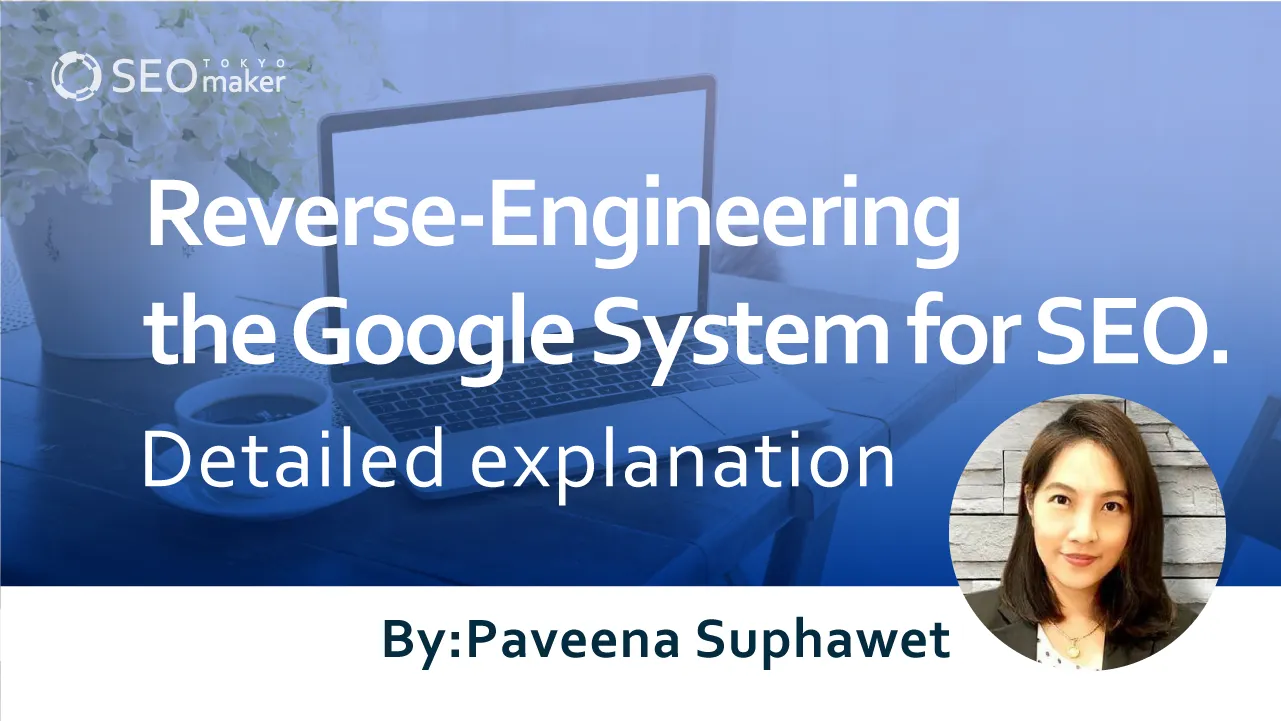Reverse-Engineering the Google System for SEO. Detailed explanation
contents

When researching SEO, numerous tips and tricks emerge. Improving search rankings, which leads to increased website traffic, is very rational from a business opportunity perspective.
However, when looking to improve search rankings, you often encounter non-logical answers, such as interpreting search intent and understanding user behavior psychology. Since Google’s search engine operates on a clear mechanical system, it logically requires strategies that reverse-engineer this mechanical system.
However, Google has prepared a highly sophisticated engine, so merely attempting to hack the system will not improve search rankings. The premise requires an approach of optimizing the system with a user-first mindset.
What is a Search Engine?
A search engine is a tool users utilize to search for information, including Google, Yahoo! JAPAN, Bing, among others. While Google and Yahoo! JAPAN are well-known as general search engines, search engines are also integrated into tools and apps like YouTube and Twitter.
The web world is vast and information is scattered. How this scattered information is delivered to users defines the mechanism of search engines. The more easily a search engine can provide desired information, the more users it attracts, enabling advertisement operations. Thus, companies are constantly improving their search engines.
Particularly, Google invests significant efforts in this area. Being the world’s most chosen search engine signifies Google’s commitment to enhancing search precision, meaning it excels in providing the information users seek.
- Google’s mission is to organize the world’s information and make it universally accessible and useful.
- The web and the world have changed over the years. Google Search has evolved and been refined, but Google’s approach remains unchanged.
- Google continuously maps the web and other sources to deliver highly relevant and useful information.
- It presents results in various ways based on what will be most helpful for the type of information you are seeking.
- At the same time, it maintains the privacy and security of personal information.
Citation: Understanding How Google Search Works (Google Search)
The Role of Search Engines
The role of search engines is clear which is to provide users with the information they seek quickly and accurately. Instantly understanding the meaning behind the entered words (queries) and providing responses as swiftly as possible is essential.
Indeed, Google has succeeded in returning search results instantaneously, garnering support from many users. However, if the returned results are irrelevant, they are of no use. In this regard, Google, through continuous improvements, has become adept at interpreting even the subtle intentions of users, providing precise answers to their queries.
The Importance of SEO for Google
While the number of platforms has increased and the pathways to site access have become more complex, search engines remain the mainstream source of access as of 2022.
Thus, SEO (Search Engine Optimization), which aims to increase traffic from search engines, plays a critical role in web strategy. There’s a reason why everyone places significant importance on Google.
The graph above shows the trend of search engine share in Japan from April 2021 to April 2022, with Google and then Yahoo! JAPAN being the most used. Although Yahoo! JAPAN operates its platform, it has been utilizing Google’s search engine since 2010, effectively meaning Google holds about 90% of the search engine market in Japan.
Moreover, Google is renowned for being an optimizable search engine.
While it’s somewhat understood that other search engines also produce search results through their unique systems, all companies keep their systems entirely confidential. However, Google, while keeping its logic private, actively discloses methods for achieving higher search rankings.
Therefore, Google can be said to use a system suited for SEO for two reasons:
- It holds 90% of the market share in Japan.
- It is an optimizable search engine.
As an aside, many search engines exist worldwide, and in some countries, systems other than Google are frequently used. However, some search engines are difficult to optimize, making it challenging to achieve higher rankings regardless of effort.
In this sense, Google uses a very rational system, but among those who do not use Google, some argue against it because “it’s optimized for SEO.” This signifies that Google has implemented a system that is easy to optimize.
The Mechanism of the Google System
Google is a company that steadfastly adheres to a user-first philosophy.
Normally, longer dwell times on websites are considered beneficial. A longer dwell time indicates that content is being read for extended periods and that there is navigation through the site, suggesting a higher likelihood of increased engagement.
However, as Google provides a search engine system, it is designed to allow users to input keywords easily and to provide information as quickly as possible. In other words, it aims to be the site with the shortest dwell time in the world.
Even if it seems to go against the common wisdom of the web industry, Google will implement what it deems beneficial for users. This approach is evident in various systems provided by Google, so understanding Google’s philosophy and the mechanism of its search engine can assist with SEO.
Google’s Philosophy
Insight into Google’s approach to SEO can be gleaned from the article “Inside Google Marketing: 3 Tips to Maximize the Impact of Your SEO.”
In this article, Google mentions several methods to increase web traffic, highlighting SEO as a cost-effective and superior technique through real-life examples.
The following three points are considered when thinking about SEO from the system’s perspective:
- Continuation of small efforts should be pursued.
- New features should be actively incorporated.
- Integration should be pursued as much as possible.
Continuation of Small Efforts
Continuing small efforts might sound abstract, but Google mentioned the following three critical elements:
- URL normalization
- XML sitemaps
- Metadata
These are all elements commonly regarded as important for SEO.
URL normalization, which includes integrating http and https or the presence of www, instructs the search engine system to evaluate a specific URL when multiple URLs exist, preventing the dispersion of evaluations.
Related Article: Methods of URL Normalization (Redirects or Canonical Settings)
XML sitemaps make it easier for the search engine system to crawl, thereby making it easier for results to appear in searches. XML sitemaps might not be necessary for small sites, but they are a must for sites of a certain size or larger.
Metadata refers to the title, description, and meta keywords. The title tag, in particular, is one of the most critical points in SEO, as the inclusion of keywords in the title or the interpretation of the title’s meaning can significantly influence search rankings. The description appears below the title in search results and affects the click-through rate. Meta keywords are said to be unrelated to SEO, but some people set them out of convention.
New Features Should Be Actively Incorporated
The Google system actively reflects newly widespread technologies. The article by Google introducing AMP and PWA was published in May 2019.
AMP (Accelerated Mobile Pages) is a technique for speeding up mobile page loading, a technology that has been actively adopted since around 2015. As of 2022, the benefits of implementing AMP are not as significant, but at the time, its adoption was recommended.
PWA (Progressive Web Apps) is a mechanism that makes websites for mobile as usable as smartphone apps. This technology is still in use today, illustrating Google’s stance on adopting any technology that is convenient and beneficial for users, regardless of what it may be.
Integration Should Be Pursued Where Possible
As a site grows, it’s common for pages with similar meanings to be unintentionally created. This issue becomes even more prevalent when expanding internationally and creating multi-language sites, often resulting in duplicate pages.
In such cases, Google advocates for integrating these pages into a single page wherever possible. Google has shared case studies where traffic increased after consolidating six old sites into one, thereby enhancing the quality of content.
The Mechanism of Google’s Search Engine
Google’s search engine mechanism consists of three main processes:
- Crawling
- Indexing
- Ranking
Given these three components are integral to the system, SEO strategies should focus intensively on these areas.
Crawling
Search engines rely on robots called crawlers (Google bot) to collect information on the web. While crawlers are highly efficient and can find newly created sites, they typically discover new pages by following links from known sites, so spreading internal links can enhance SEO.
For large known sites, internal links alone may not suffice for comprehensive crawling. In such cases, an XML sitemap is referred to.
This system structure indicates that maintaining an XML sitemap and optimizing internal links are effective for SEO.
Related Article: What are Internal Links?
Indexing
After a crawler finds a page, it decides whether the page should be displayed in search results and registers it in the database. This process is called indexing, and if a page isn’t shown in search results, it’s likely not indexed.
Normally, content would be indexed unless it’s not relevant. Even if the ranking is low, content that meets users’ needs should appear in search results.
However, it can take time for content to be reflected in search results, especially for new sites where the initial crawl can take days, making indexing slow.
In such cases, Google Search Console can be used to request indexing. Low-quality content or pages engaging in spam may be filtered out at this stage, but generally, content can expect a high chance of being promoted in the index.
Related Article: What is Google Search Console?
Ranking
Even if a page is indexed in Google’s database, it won’t reach users if it ranks low. Google reads the content of indexed pages and ranks them for each search query.
Being indexed doesn’t guarantee a high ranking unless the content is evaluated as high-quality within the existing database.
The definition of high-quality is somewhat vague, but comprehensive SEO content that addresses users’ needs is effective. However, merely stuffing information makes content hard to understand, and copying from other sites results in duplicate content.
High-quality definitions likely include providing unique information, clarity, and the source of the information.
Related Article: What is SEO Writing?
SEO Utilizing the Google System
The previous section introduced SEO elements derived from Google’s ranking system, but SEO considering the entire Google system involves the following five points:
- Search intent
- Relevance to the query
- Category organization
- Content quality
- Site usability
SEO involves very detailed tuning, so the list of strategies could be endless. However, many strategies may have minimal impact, necessitating SEO countermeasures derived from the search system. Refer to this for prioritizing efforts.
Search Intent
Important in content creation is understanding the search intent, which is why a user has searched.
It might simply be entering something unknown, but researching can lead to a desire for more detailed information or uncover unexpected information. Not only the explicit information users seek but sometimes even latent information must be covered, necessitating focus from the planning stage of content creation.
Relevance to the Query
Even if you focus on producing high-quality content, there might be times when your search ranking does not improve. Often, this is due to a weak correlation between the site’s theme and the query.
Sites strong in SEO typically have a clear theme, and especially sites that rank high shortly after launch are often niche sites with highly focused themes. This is because they are designed with search queries in mind.
Articles unrelated to your site’s theme are unlikely to rank well, so a scattergun approach like that of a miscellaneous blog is not recommended. Conversely, if it relates to the theme, even if search volume is low, you should actively target long-tail keywords.
Even when targeting big keywords in site creation, strategically, it’s wise first to capture middle and then small keywords. To gather evaluations from Google, countermeasures reverse-engineered from the system are necessary.
Category Organization
As you add more content, categorization can become an issue. Ideally, categories should be neatly organized from the start, but surprisingly, many sites struggle with this.
Google’s system evaluates not only sites but also directories. Always consider the most appropriate category for content as you build your site.
Content Quality
The issue of content quality is complex. Previously, having a high word count and including many keywords were considered advantageous, but this is not necessarily the case today.
Especially with the emphasis on E-A-T and the quality and quantity of external links, simply pursuing content quality may not lead to higher rankings.
However, covering information users deem necessary, writing clearly and logically, and providing information from an authoritative stance are crucial points.
Site Usability
While site usability is not directly related to SEO, it indirectly affects SEO-related points. For example, display speed and UI/UX affect user navigability and bounce rate.
High navigability implies longer dwell times on the site, extending the duration between the initial search and the next. A high bounce rate suggests a high likelihood of moving to the next search action.
Google has stated that information viewable in Google Analytics (such as access numbers, user numbers, bounce rates, direct return rates, dwell times, etc.) does not affect search results, but user behavior is monitored.
In other words, a short duration between the initial and next search suggests that the desired information was not found, acting negatively, while a longer duration suggests the desired information was found, positively impacting.
Although Google has never disclosed the inner workings of its system, activities by many volunteers have suggested that search behavior is related to search rankings.
Summary
While there are numerous contents aimed at improving search rankings earnestly, given that a machine makes the judgment, mechanical countermeasures are necessary. Especially in recent years, there’s a noticeable emphasis on content SEO, but the premise is a site structure designed with an understanding of the search engine system. This is called internal SEO measures, and neglecting internal SEO makes it very difficult to improve search rankings. It should be the first point of action for overall optimization.










![What is a Description? Explaining the Meaning, Writing Style, and Changing Word Count – [2023 Edition]](https://www.switchitmaker2.com/en/wp-content/uploads/2024/09/what-is-description.webp)










